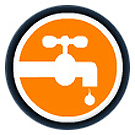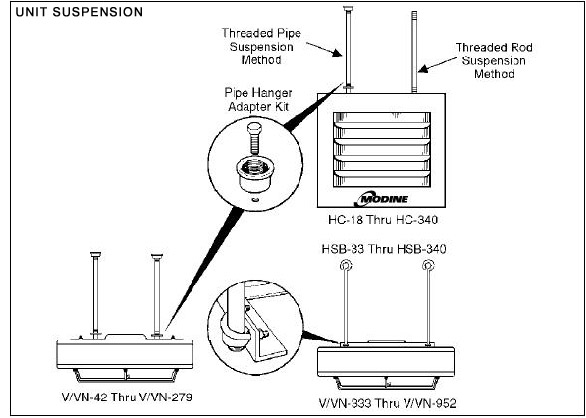Hot Water Garage Or Workshop Heater Buying Guide
Posted by NorthStock, Inc. on Dec 26th 2012

Hot Water Garage Or Workshop Heater Buying Guide
If you already use a hot water radiant system to heat your home, adding heat to your garage or workshop can be accomplished by installing a hot water garage or workshop heater. Hot water garage and workshop heaters transfer heat from the hot water to the air.
Operating Principle:
The hot water from your boiler flows through a radiator coil and an electric fan pushes air through the radiator coil. The air entering the coil absorbs the heat from the water, resulting in a warmer discharge air temperature. The cooler water leaving the coil returns back to the boiler to be reheated for another pass through the radiator coil.
Benefits Of Hot Water Garage Or Workshop Heaters:
• Clean heat, no odors, no by-products of combustion to vent.
• No open flame to worry about.
• No messy fuel oil to contend with.
• Efficient.
• Easy maintenance.
• Very reliable. The only moving part is the motor and fan assembly. If a motor fails, it is very simple to replace.
• The fan speed can be adjusted on many models. This allows you to dial in the perfect airflow.
• Low clearance requirements on units with side piping connections.
• Horizontal units have adjustable louvers to help direct warm air where you need it most.
• Durable. All unit casings are treated for corrosion resistance and finished with a gray-green baked-on, high solids paint.
• Compact and lightweight for simple installation.
• Tapped holes in the units casing allow for simple suspension using inexpensive threaded rod.
• Large electrical junction boxes allow for simple power wiring.
• Huge range of sizes to match the heater to your heating load. If selected properly, you don’t have to worry about under or over sizing.
• The fan can run in the Summer to help circulate air.
Drawbacks Of Hot Water Garage Or Workshop Heaters:
• Water in a cold garage can easily freeze if there is a failure.
• A home boiler system is required. If your boiler is down, the heater will not produce heat.
• Hot water piping is required to distribute the water from your boiler to the hot water garage heater.
• Controls can be slightly more complex due to the integration of your hot water boiler and the garage heater. See the commonly asked questions section for typical control sequences.
• Fan forced units move large volumes of air which can kick up dust in your garage.
Hot Water Garage Or Workshop Heater Unit Configurations:
Hot water garage heaters come in horizontal or vertical models. The “horizontal” or “vertical” describes the direction of airflow. A “horizontal” garage heater is typically placed along a wall and blows warm air into the space. A “vertical” garage heater is typically placed along a ceiling and blows warm air vertically down into the space. Vertical garage heaters are typically used in very large spaces. Horizontal garage heaters are typically used in smaller spaces.

There are several modifications available. Horizontal and vertical unit heaters are available with “power throw” high CFM fans, high pressure tubes, low outlet temperatures (for high steam pressure applications), special motors and custom coatings. These modifications are rarely used in the typical garage. Call us for information about customizing a garage heater to meet your specific needs.
Hot Water Garage Or Workshop Heater Installation Overview:
1) Suspend the garage heater using threaded rods that thread into the self tapping holes located on the unit heaters casing.
2) Install hot water piping from your boiler or wood furnace to the hot water garage heater.
3) Wire the hot water garage heater fan motor.
4) Install controls.

Commonly Asked Questions:
1) How do I calculate the heating load for my garage or workshop?
ANSWER: Contact H-Mac or use this simple garage heater calculator tool. Do NOT fall for equipment that is advertised as “will heat up to 400 square feet”. Heating a 400 square foot insulated garage in Florida is a lot different then heating a 400 square foot un-insulated metal garage in Maine. 1 heater can not magically service both 400 square foot spaces. Call us; we are happy to run a detailed engineering calculation that will help you pick the perfect heater for your space. You do not want to undersize, and you do not want to oversize.
2) How do I control my hot water garage or workshop heater?
ANSWER: If there is always hot water running through the coil, you can simply use a switch to turn the fan motor on and off when you are using your garage. Automatic control is preferred over manual control. There are 3 common methods for automatically controlling a hot water garage heater:
Common Control Sequences
The following control sequence descriptions are typical for steam/hot water garage heaters:
>>Intermittent Fan Operation - Hot Coil
When a room thermostat calls for heat, the motor is energized. Hot water or steam is continuously supplied to the unit heater, even when the motor is not running. When the thermostat is satisfied, the motor is de-energized.
>>Continuous Fan Operation - Intermittent Hot/Cold Coil
When a room thermostat calls for heat, a valve is opened, allowing steam or hot water to enter the garage heater. When the thermostat is satisfied, the valve is closed. The fan runs continuously.
>>Intermittent Fan Operation - Intermittent Hot/Cold Coil
When a room thermostat calls for heat, the motor is energized. At the same time, a valve is opened allowing steam or hot water to enter the garage heater. An aquastat may be attached to the supply or return piping to prevent fan operation until the coil is adequately heated to avoid cold air delivery. When the thermostat is satisfied, the valve closes and the motor is de-energized.
3) How do I determine how much heat a hot water garage or workshop heater will generate with varying entering hot water temperatures?
ANSWER: Hot water garage heaters are also used with steam. The major hot water garage heater manufacturers rate their capacities using 2 psi steam. For example, a Modine model HSB33 will produce 33,000 BTUs when it is hooked up to 2 PSI steam. Another example: A Sterling model HS120 will produce 120,000 BTUs when hooked up to 2 PSI steam. Since you are most likely using hot water in your garage, you need to know how much heat you will get out of the garage heater with your specific hot water tempaerature. Call us. Within minutes we can tell you the exact output for every sized heater under any condition. Do not fall for advertisements that claim “290,000 BTUs!”. A size 290 garage heater will produce 290,000 BTUs ONLY if it is supplied with 2 PSI steam. If you are using 160F water, this same heater will produce 152,000 BTUs, almost half the capacity shown on the advertisement.
4) Can hot water garage or workshop heaters be used with outdoor wood furnaces?
ANSWER: Absolutely. The coil doesn’t care where the hot water comes from. As long as the water is warmer then the air, the unit heater will transfer heat from the water into the space.
5) What are the different piping configurations on hot water garage or workshop heaters?
ANSWER: The most common hot water garage heater is the horizontal model. Most major manufacturers offer side piping and top and bottom piping arrangements on horizontal heaters. The side piping connection models allow you to install the heater closer to the ceiling. The top and bottom piping connection models allow you to easily rotate the heater if you need to change the direction it is pointing.
6) What is the best location in my garage or workshop to install my hot water heater?
ANSWER: The hot water garage or workshop heater should be located in the coldest area, and it should be angled slightly so it blankets warm air across the coldest wall.
7) What is the best location to install a wall mounted thermostat in my garage or workshop?
ANSWER: The thermostat should be mounted in a location that represents a good average temperature in your garage. If it is located in a cold spot, it will falsely run the garage heater more then it should. If it is located in an area that receives direct sunlight, it will falsely run the garage heater less then it should. A well insulated interior wall is the best spot for the thermostat.
8) What is an aquastat?
ANSWER: An aquastat gets strapped on to the supply or return hot water pipe. It gets wired in series with the fan motor. The aquastat will only allow the fan to run when there is hot water running through the pipes. This inexpensive device will prevent cold air from circulating throughout your garage when the hot water pipes are cold.
9) What kind of sound can I expect from a hot water garage or workshop heater?
ANSWER: While sound is created anytime fans and motors are used to move air, Modine garage heaters are designed to minimize their sound level through the careful selection of motors, fan blades and the design of the air intake opening. The information below shows typical types of buildings or rooms with a corresponding Sound Class rating. For a heater with a given Sound Class rating, when placed in the type of building or room shown below, the sound of the heater will be relatively comparable to the ambient sound level of all sounds within that type of building or room. When purchasing a garage heater, ask for the the sound class rating to be sure you are buying something that will fit your application.
Sound Class Ratings
Type of Building or Room Sound Class Rating
Apartments, Classrooms, Court Rooms, Executive Offices, Hospitals, Libraries, Museums:
Class I
General Offices, Hotel Dining Rooms, Recreation Rooms, Show Rooms, Small Stores:
Class II
Bank Lobbies, Grocery Stores, Gymnasiums, Post Offices, Restaurants, Service Stations:
Class III
Factories, Foundries, Machine Shops, Packing Plants, Shipping Platforms:
Class II-VII
Forge Shops, Steel Fabricating Shops, Boiler Works:
Class VII
10) How can I compare the cost of heating my garage or workshop with different types of heaters?
ANSWER: Contact H-Mac. We will first run a heat load analysis, and then we can run an energy comparison analysis based on your local fuel rates.